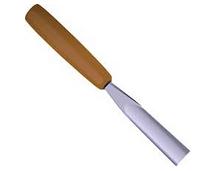 The Old French word cisel came into our language as chisel . The term refers to a tool that is used to carve metals and stones through blows made with a hammer .
The Old French word cisel came into our language as chisel . The term refers to a tool that is used to carve metals and stones through blows made with a hammer .
The chisel has a double-bevel mouth , the edge of which must be resharpened frequently to remain effective. The ends of the chisels can vary according to the use for which they are intended: there are serrated chisels , flat chisels and other types.
Already in Prehistory, man used chisels that he built in stone . Starting in the so-called Age of Metals , chisels began to be made with bronze, copper, iron and other materials. These tools were used to carve stone, wood, leather and more elements.
In a chisel you can distinguish the head (the end that is struck with the hammer), the body or handle (which allows the blows to spread), the wedge (the lateral sectors of the cutting part) and the cutting edge ( that carries the blow to the stone that is being worked).
Stonemasons and bricklayers, for example, use chisels to modify the surface of stones and other materials. To do this, they hold the chisel with one hand and place its tip on the surface: with the other hand, they hold a hammer that they hit with the chisel. The successive impacts of the chisel tip on the rock shape its surface.
It is important to keep in mind that choosing the right chisel is key for the job to offer the desired result. If a chisel with unsuitable characteristics is used, the carving will not be satisfactory.
chisel plow
A vertical tillage instrument is known as a chisel plow that gives the possibility of tilling the soil without the need to invert it through the intermixing of plant remains on its surface. In recent times, it has managed to gradually replace moldboards and discs to break up the soil.
 By using a chisel plow it is possible to prepare the soil so that its surface is protected with plant remains to resist water erosion without the mixing of the strata being extreme. Thanks to this tool, compacted soil can be broken up to promote water infiltration.
By using a chisel plow it is possible to prepare the soil so that its surface is protected with plant remains to resist water erosion without the mixing of the strata being extreme. Thanks to this tool, compacted soil can be broken up to promote water infiltration.
When we talk about vertical tillage we refer to the characteristics of the tools and elements with which the breaking, bursting or cracking of the soil is carried out, which in this case have supports oriented vertically.
Let's look at some of the advantages of this type of plow:
* since it requires much less traction force than other types of plows, there is an approximate energy saving of 50%;
* the soil retains moisture better and is adequately aerated, thanks to the fact that the chisel plow allows water to filter effectively;
* avoids and corrects the problem known as "plow foot" or "compacted stratum ", which arises as a consequence of always working the soil at the same depth or with an inappropriate degree of humidity, something that occurs with other types of plows;
* the chisel plow reduces soil erosion thanks to the fact that vertical work displaces the residue of the previous harvest much less than horizontal work, and therefore wind and water cannot affect it with the same magnitude;
* reduces weeds precisely because of not inverting the soil;
* improves the structure of the land and its properties, so that it lasts longer and performs much more.
